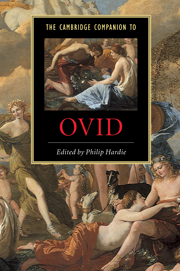Book contents
- Frontmatter
- Introduction
- Part 1 Contexts and history
- Part 2 Themes and works
- 5 Ovid and genre
- 6 Gender and sexuality
- 7 Myth in Ovid
- 8 Landscape with figures
- 9 Ovid and the discourses of love
- 10 Metamorphosis in the Metamorphoses
- 11 Narrative technique and narratology in the Metamorphoses
- 12 Mandati memores
- 13 Epistolarity
- 14 Ovid’s exile poetry
- Part 3 Reception
- Dateline
- Works cited
- Index
8 - Landscape with figures
aesthetics of place in the Metamorphoses and its tradition
from Part 2 - Themes and works
Published online by Cambridge University Press: 28 May 2006
- Frontmatter
- Introduction
- Part 1 Contexts and history
- Part 2 Themes and works
- 5 Ovid and genre
- 6 Gender and sexuality
- 7 Myth in Ovid
- 8 Landscape with figures
- 9 Ovid and the discourses of love
- 10 Metamorphosis in the Metamorphoses
- 11 Narrative technique and narratology in the Metamorphoses
- 12 Mandati memores
- 13 Epistolarity
- 14 Ovid’s exile poetry
- Part 3 Reception
- Dateline
- Works cited
- Index
Summary
In Ovid’s Cave of Sleep, three shape-shifting spirits (pre-eminent among the thousand sons of Somnus) fashion and enact dreams for kings and leaders: one has the power to assume human forms, one the forms of beasts, and a third, of diverse art (diuersae artis), the forms of 'earth, rocks, water, trees, all lifeless things' (Met. 11.642-3). As in Somnus' subterranean dreamworks, so in the epic Metamorphoses at large one of the privileged ingredients of Ovidian myth-making is the deployment of elements of natural setting: the poem constitutes a significant intervention in the history of landscape. Briefly put, Ovid’s contribution to this history is to appropriate and renew the highly rhetorical and idealized tradition of landscape description as he inherits it, to enhance its self-consciousness, to mythologize its origins and accumulated generic associations, to extend the kinds of action which it stages, to exploit its potential for interplay between verbal and visual imagination, and to add a specifically cosmological accent by describing a metamorphic world in which the setting may always be more than just a setting. Partly because of the potency of his own appropriations, and partly because of the circumstances of transmission and survival which give him such prestige as a bearer of the classical tradition to medieval and early modern Europe, Ovid becomes a key collaborator in shaping aesthetics of landscape in later literature, as also in later visual art.
- Type
- Chapter
- Information
- The Cambridge Companion to Ovid , pp. 122 - 149Publisher: Cambridge University PressPrint publication year: 2002
- 18
- Cited by



